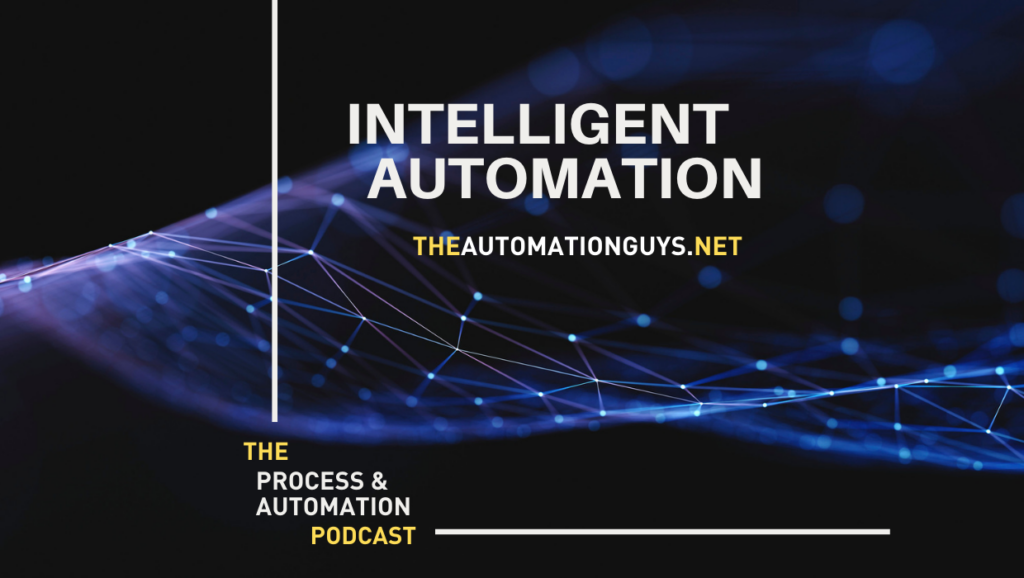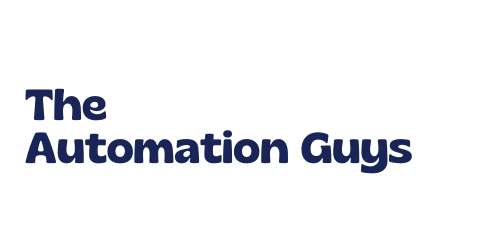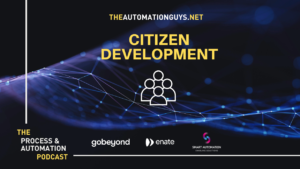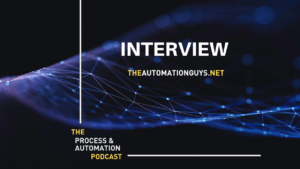Blog

In this episode of The Process & Automation podcast, The Automation guys discuss Gartner’s prediction that by 2025, 70% of new apps developed by enterprises will use low-code or no-code resources.
After covering the low-code and no-code trends and technologies in previous episodes, The Automation guys discuss Microsoft Power Platform, what the Power Platform is and why business should give it a go.
Share This Post
The #1 source of knowledge for everything automation: https://theautomationguys.net
Do you have any questions? Would you like to give us feedback? Are you interested in workshops on the topic of automation? Are you an expert in the field of automation and would like to be on the podcast? Let us know: https://bit.ly/3lyq9Yj
Episode Transcript
Sascha: Hello and welcome to another episode of The Process and Automation podcast with The Automation guys. My name is Sascha Cutura and I’m here with the other automation guy Arno. Hello, Arno.
Arno: Hi Sascha.
Sascha: So, Arno in the recent weeks, we have been asked I guess a lot of times, isn’t it, how we see the strong push and the success from Microsoft in the low code space.
Um, and yeah, that’s why we thought it will be great to talk about the, the Microsoft Power platform, the power apps, the power automate all the different terms associated with the power, power platform. And, um, I think it was around sort of the end of last year when Gartner published their report called enterprise low code application platforms.
So one, one of those reports, everyone is looking out for in that space. And there are lots of reports from Forrester and Gartner and a few other analyst firms. So this is a very big one. So when Gartner says they are the leaders, everyone is looking at it, it isn’t it. And, uh, and as one of the leaders, um, um, yeah, Microsoft is now on there with it’s low code power apps service offering. And, over the years, um, they climbed up more higher and higher and coming through they are here at the leaders quadrant next to, uh, OutSystems, maybe you have heard about Mendix, Salesforce as a very big one there and ServiceNow.
Yeah. Some other really, well-known names, uh, now and the challengers probably they would have seen themselves more in the leaders part is Appian, Pega, Oracle and then, there are a few, few other vendors, they’re just, on the sort of niche players part of the, of the quadrant is Kintone, Newgen, Quick Base and Creatio was actually making good push in the market at the moment.
But yeah, Microsoft, there is a leader and this is why we have that episode here today as well. And yeah, throughout that report, Gartner also predicted that by 2025, 70% of new applications develop within larger companies and enterprises we’ll be sort of low code and no code technologies and that’s a huge increase from 2020 where it was just 25%. So that’s a big, increase and driven by lots of things we have seen over the last 24 months, we have covered, covered that, that low-code no-code technologies and the trends here on the podcast several times.
So feel free to jump to other episodes we have recorded and because there is a huge increase in that topic we have decided to look at that power platform specifically and we’ll cover, um, sort of the benefits of the platform and of course, we also will share a few examples why that is a good platform to use So Arno let’s tell the listeners what the Microsoft Power Platform is.
Arno: Yes. Thank you, Sascha. So that was a really interesting intro there with the Gartner reports and the leaders, and it’s, it’s fairly obvious that Microsoft is sort of creeping towards that top spot.
And, you know, a lot of people are asking us, what is the power platform and what can you do with it? In a nutshell, the power platform is just a set of low and nocode tools with inside Microsoft 365 that you can create business applications with. So the whole power platform might be a fairly new concept but the components that makes it up is it’s not new. And I’ll summarize these components for you. So power apps is one, power apps is something that you can build custom applications very quickly and easily using no or low code, you could bring data in from different data sources, like SharePoint, Excel, Oracle database, sort of API and surface that in these easy to create apps that citizen developer, so these are people that’s kind of business people that are very good with Excel and they’re very good with their data. They can sort of create these productivity apps with inside power apps, um, you know, without prior knowledge of technical coding or how to build customer applications or perhaps integration with other systems.
So these apps are, are very easy to assemble within power apps, it’s all with inside the Microsoft 365 environment. So it’s very easy to get started as, and it’s not a very high barrier of entry in terms of getting these apps developed. So the apps is a key component.
And then also we’ve got something called Power BI. So Power BI is a tool that allows you to visualize and analyze your data. And that gives you very good insights, very quickly to make informed decisions. And, you know, you can then use that information that this power BI reports provide you and apply changes inside your business.
So you might have a power app that harvest some data. You might have some Power BI reports that gives you some information based on the data. You might actually integrate that with various other systems. Um, so you’ve got this user interface, but you’ve got this reporting bit, but then you also have automation bit. So power automate is a very easy way to automate and integrate, um, you know, business processes. So you can look at a business process, um, and you know, it might be an approval and with inside, power automate, you can actually implement an approved process that assigns tasks to various people.
Now, when you leverage power automate, it allows you to turn very time-consuming tasks into fast automated workflows. And that obviously frees up resources that can concentrate on your core business. So, you know, power automation is a powerful thing as the name suggests and you know, it does increase productivity with inside your company, because it obviously provides you the ability for automations.
So again, we’ve covered the user interface, but we can create these nice apps connected to your data. We looked at this power BI bit, which is the reporting, and we’ve brought in the, the process automation and the final component with inside the power platform is the virtual agents. Now these are chatbots essentially, where you can create, um, very sophisticated, uh, chatbots and you can do this without the help of any developers or without any knowledge of complex complicated coding. So again, with this platform, you can create really rich business applications, you know, that you drive productivity and you solve sort of day-to-day problems that you would have done, uh, you know, otherwise by creating a spreadsheet and emailing that to colleagues for, um, for approval or so. Very popular, you know, obviously Microsoft is pushing the power platform really hard. Um, it’s, it’s very easily accessible. Um, and you know, it is, it is a valid contender, you know, with the insight that sort of Gartner leadership board.
Sascha: And especially when we talk about the enterprise low code side of it, lots of companies, larger organizations, enterprises to have, have some form of, um, uh, sort of free, free version of that already available, so they have some really big license agreements, which make that’s sort of available, to anyone who wants to try it out without sort of incurring immediate costs, maybe. Um, so this is why it gets so much, so much traction at the moment because pretty much every enterprise is running on Microsoft, right?
And, um, uh, yeah, and as well with this genius move to, to, to bring the power automate onto every windows 11 machine so just sort of more the, attended RPA functionality, bringing that onto a windows machine. Yeah. That’s great. So this is why everyone is talking about it and, um, And yeah.
And the reasons why we’re doing this, of course, or what businesses are doing are, are quite, quite clear. As we talk about low code, and low code opportunities here on the podcast a lot, the big, the big reason is companies do not have sort of staff or lots of staff available to actually get to do the normal traditional development.
Isn’t it? So, and there’s so many ideas out there. So with the power platform, for example, you can give your employees the opportunity to actually create these applications, even chat bots, integrations, even AI capabilities in, that power platform, we talked about this year as well on the podcast.
So, so you make that available for employees without being sort of a proper high code developer or pro developer. Usually those things will be very scary for, for normal business people to do. Um, so now with that capability of the platform, um, they are now able to build their own solutions, with very little technical knowledge. That’s one of the very big, big benefits. And generally that’s, that’s true. Not just for the power platform for, for low code. Um, so whatever platform you might use, but, this is one big benefit, um, using the platform.
Arno: Yeah. I mean, uh, another good benefit or big benefit is, uh, mobile accessibility.
All of these tools with insight of our platform, um, you can download a mobile phone app or app to your tablet and all of these apps can be, optimized for these different types of screens. Um, so you know, people can use these apps and visit your dashboards and read these reports from any device.
So, you know, the power platform, it can be as simple as it needs to, but they always say, um, It provides power when you need it. So if you want to do more complicated things, for example, um, the power is there. You know, you can go very deep and you can create very sophisticated applications.
Sascha: Yeah, I think that’s a, obviously we had as well a sort of offline capabilities and, and sort of workforce is doing audits so yeah, this is, um, this is something which is also possible once, once an application is built, downloading on the tablet or mobile and yeah. Okay, so, so the next huge benefit is of course, automation of business processes. So having processes from manual, um, and on paper and suddenly have them digital that’s, that’s great.
But, um, I think the next big thing is really, um, sort of the automation and the majority of these, um, repetitive and mundane time wasting kind of tasks. Um, so the automation of that is this very much in focus. We of course had, sort of the last 24 months where we had to deal with a very difficult situation and with working from home and all that stuff.
So automation, um, became more, more of a focused topic and that of course continues. Um, we all want to get more done with sort of less of resources, want to be more efficient. So, so to increase sort of general productivity with that power platform, a business have the opportunity to really automate that work process the sort of end to end process and, um, yeah, orchestrates, basically lots of things as part of the whole process and it’s a big driver for digital transformation in your business.
Arno: And we talk about in the last sort of year and a half to two years coming out for two years and people needing more flexible working environments and flexible working opportunities.
And I think one of the things that, um, you know, low code platforms, the power platform included in that provides is this, you know, high degree of flexibility to force employees to build these bespoke solutions, to meet their productivity requirements. Right. And again, with the power platform, that’s all integrated with Microsoft teams, for example.
So you can publish your apps to teams, so that just allows your employees and, um, you know, your members of your team to, you know, improve their business processes and be more efficient by creating these seamless working experiences. So. Again, the power platform is really ideal tool for, for, you know, turning your business into a, sort of a modern working flexible workplace.
And, um, you know, I think in it, like I said in the last few years become so used to teams, there’s so many, you know, collaboration around teams. So that’s a perfect place to put your applications for, for new intake of work or to start the process when somebody actually sends a message or upload a document.
Um, so it’s, it’s a really good catalyst for that, that sort of greatness, flexible working scenarios.
Sascha: This is really, really great. Um, I think a great advantage for, for the power platform or maybe another reason why it becomes so popular, all businesses are already running on Microsoft technologies Word SharePoint, all these things were already, or very, very much, um, um, in place, um, for companies. And now with a power platform on top of it or underneath, or how you want to describe it, you have the power of process automation and all that stuff suddenly, it’s connects it all up, isn’t it?
So it’s just very, very powerful thing because it’s already there. Everything is on a Microsoft 365 platform and, um, security is already taken care of and all that stuff. So this is, this is why it works so beautifully.
Arno: Yeah. And of course, if you have, um, the need for ERP system, because of course a lot of these low-code and no-code applications can exist in a silo.
And, um, but of course, with the Microsoft offering, um, you can actually subscribe today, Dynamics, ERP system, which is dynamics 365, so in a way, that’s your line of business system, that’s your single source of truth. And, you know, that’s the place where you have your orders and your contacts, and you know, all of the, all of the various sort of ERP assets that you need so you could build power automate solutions or power apps against that as well. So it really provides a powerful sort of mix of we’ve got our source of truth, but we are opening up, um, you know, the opportunity for, for people in the business to actually develop their apps against the ERP system. Um, and of course, Microsoft dynamics is built on top of power app as well, and it uses flows.
And so all of that is, you know, integrated your data’s in the data verse so, so it’s all very, very tightly integrated with your Microsoft 365 tenant. And, uh, and I think that is part of the reason why Microsoft is moving into that leadership space is to get started power when you need it, easiest subscription models, and you know, obviously big scalability opportunities
Sascha: Just mentioned data verse probably that’s, uh, that’s one, uh, one topic we can cover in one episode at some point. And everything metaverse Dataverse, it’s all very, become all becoming very popular those kinds of terms. So we will have a episode just about that.
Um, yeah. You mentioned data, um, um, data sources and of course ,within a business, large small to large enterprises, generate crazy amount of data these days and having that within the, the platform and the Microsoft 365 sort of Dataverse and then, um, you can access to data, um, and, and really gain sort of valuable insights.
So we looked at, um, uh, Arno mentioned the power BI tool as part of the, the power platform so with that you can look at that data, you slice and dice and predict and bring AI in it, that kind of stuff. So that, that will help businesses to, to get all the insights they need and to keep improving.
Um, uh, I think that’s, that’s very important that the business are continuously improving and with that, that tool power BI and this enable us to do that.
Arno: So I hope that’s a very insightful for our listeners. We do get a lot of questions about the power platform. I think it was about time to sort of just touch on, on it again, um, specifically after the back of the Gartner report.
So I’m pretty sure we’ll, we will keep that in the topic list in 2022 to continue to talk about that just to, to bring to our listeners, you know, some of the developments, uh, with inside that space, um, it is definitely very interesting what Microsoft’s doing. And, um, you know, we, we are seeing a lot of, um, sort of businesses leveraging, um, you know, the power platform to, to get started with automation and to scale as well with, with insight their, I guess their digital transformation journey.
Sascha: Yeah. And of course, um, platforms like the power platform and like many other low code platforms sort of have that citizen developer or the non high code developer in mind. Um, but, but generally from, from our experience, they are the best off of those implementations are done with a bit of guidance and support and that kind of stuff. So if you, if you feel, um, yeah, you like to get a bit more sort of specialist insights, more than just what you hear on the podcast, please reach out to Arno or myself by email or on, on, on our social channels, Instagram, LinkedIn, and then of course we are very happy to, to help you.
And, um, yeah, so that’s, that’s it again for another episode of the automation guys podcast, it’s not called the automation guys podcast, actually it is called the process and automation podcast but we are the automation guys. Thanks for listening. And, uh, um, yeah, looking forward to, to welcome you soon again, and until then, let’s automate it.
Unfortunately, that’s it again with this episode of The Process and Automation podcast. If you liked this episode, please give us a five-star rating and don’t forget to subscribe to this podcast so you don’t miss any upcoming episode. We hope you will tune in next time. And until then let’s automate it.
- February 28, 2022
- 3:03 pm


